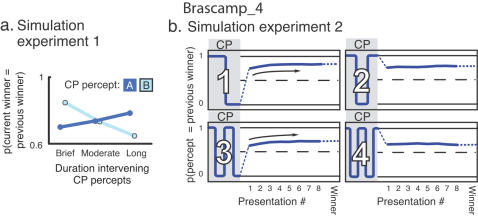Figure 4. Model simulations.
Our key findings are replicated by a model in which information on past perception is contained in the adaptation states of sensory neurons. a, Influence of one intervening perceptual switch on perceptual stabilization (cf. Figure 2b). The relation between percept durations A and B (see Figure 2a) and perceptual stabilization is replicated by the model. b, Influence of multiple intervening perceptual switches on perceptual stabilization (cf. Figure 3c). The probability that the previous winner is perceived during the current intermittent presentation sequence decreases with an increasing number of intervening switches, in line with the experimental data. In case the final percept during continuous viewing was opposite to the previous winner (one or three switches) the probability rises during the current intermittent presentation sequence (Spearman p<0.01; ρ = 0.95 and 0.92 for one and three switches, respectively), consistent with our experimental findings.

